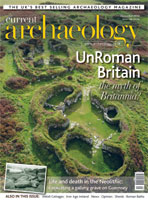When a country is invaded, how far does the native population adopt the culture of their conquerors? Do they make changes willingly or is assimilation seen as necessary for survival? These questions resonate through current world conflicts, as well as in CA 249’s opening article, which tackles the question of whether Britain was thoroughly, or selectively, Roman.
Just how much the Romans did do for us becomes evident, however, when taken in light of the challenges Ireland has faced without the benefit of Britain’s left-over Roman road infrastructure. Our third feature on Celtic Tiger archaeology looks for the Celts, the invisible people who shaped Ireland’s distinctive culture in the absence of Rome’s influence. This need to excavate the lives of everyday people to better understand their culture is highlighted by a story on Welsh cottages that examines the traditions of inhabitants of Wales from the earliest times to the present. We close with a rare gallery grave on Guernsey.
FEATURES/n
UNROMAN ATTITUDES/n
Exposing the myth of Britannia
Did native Britons enthusiastically adopt Rome’s ways? Or were they pragmatic survivalists?
WELSH COTTAGES/n
Building traditions of the rural poor
A new study of cottage-building history reveals everyday life in Wales’ countryside.
IRELAND’S INVISIBLE PEOPLE/n
The Celtic past meets the Celtic present
Has a decade of commercial archaeology found the elusive Celtic past in Ireland?
LIFE AND DEATH IN THE NEOLITHIC/n
Excavations at Delancey Park
A rare Neolithic gallery grave on Guernsey tells the story of life and death 4,500 years ago.
News
Roman armour at Caerleon; Cumbria’s £2 million parade helmet; Community excavation of Medieval hall; Iron-Age and Roman Burrough Hill; Infanticide at Vindolanda; Adelaide’s Antipodean future; Saxon window in Boxford./n
Review The Artificial Ape: how technology changed the course of human evolution/n
Last Word
Editor in Chief Andrew Selkirk reviews the refurbished Roman Baths at Bath./n
Odd Socs National Heritage Ironwork Group/n

